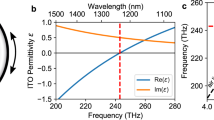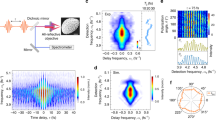Abstract
All-optical control of plasmons can enable optical switches with high speeds, small footprints and high on/off ratios. Here we demonstrate ultrafast plasmon modulation in the near-infrared (NIR) to mid-infrared (MIR) range by intraband pumping of indium tin oxide nanorod arrays (ITO-NRAs). We observe redshifts of localized surface plasmon resonances arising from a change of the plasma frequency of ITO, which is governed by the conduction band non-parabolicity. We generalize the plasma frequency for non-parabolic bands, quantitatively model the fluence-dependent plasma frequency shifts, and show that different from noble metals, the lower electron density in ITO enables a remarkable change of electron distributions, yielding a significant plasma frequency modulation and concomitant large transient bleaches and induced absorptions, which can be tuned spectrally by tailoring the ITO-NRA geometry. The low electron heat capacity explains the sub-picosecond kinetics that is much faster than noble metals. Our work demonstrates a new scheme to control infrared plasmons for optical switching, telecommunications and sensing.
This is a preview of subscription content, access via your institution
Access options
Subscribe to this journal
Receive 12 print issues and online access
$209.00 per year
only $17.42 per issue
Buy this article
- Purchase on Springer Link
- Instant access to full article PDF
Prices may be subject to local taxes which are calculated during checkout




Similar content being viewed by others
References
Anker, J. N. et al. Biosensing with plasmonic nanosensors. Nature Mater. 7, 442–453 (2008).
Sidiropoulos, T. P. H. et al. Ultrafast plasmonic nanowire lasers near the surface plasmon frequency. Nature Phys. 10, 870–876 (2014).
Oulton, R. F. et al. Plasmon lasers at deep subwavelength scale. Nature 461, 629–632 (2009).
Atwater, H. A. & Polman, A. Plasmonics for improved photovoltaic devices. Nature Mater. 9, 205–213 (2010).
Yu, N. & Capasso, F. Flat optics with designer metasurfaces. Nature Mater. 13, 139–150 (2014).
Aouani, H., Rahmani, M., Navarro-Cia, M. & Maier, S. A. Third-harmonic-upconversion enhancement from a single semiconductor nanoparticle coupled to a plasmonic antenna. Nature Nanotech. 9, 290–294 (2014).
Kauranen, M. & Zayats, A. V. Nonlinear plasmonics. Nature Photon. 6, 737–748 (2012).
Li, W. et al. Ultrafast all-optical graphene modulator. Nano Lett. 14, 955–959 (2014).
MacDonald, K. F., Samson, Z. L., Stockman, M. I. & Zheludev, N. I. Ultrafast active plasmonics. Nature Photon. 3, 55–58 (2009).
Wurtz, G. A. et al. Designed ultrafast optical nonlinearity in a plasmonic nanorod metamaterial enhanced by nonlocality. Nature Nanotech. 6, 107–111 (2011).
Harutyunyan, H. et al. Anomalous ultrafast dynamics of hot plasmonic electrons in nanostructures with hot spots. Nature Nanotech. 10, 770–774 (2015).
Noginov, M. A. et al. Transparent conductive oxides: Plasmonic materials for telecom wavelengths. Appl. Phys. Lett. 99, 021101 (2011).
Chihhui, W. et al. Metamaterial-based integrated plasmonic absorber/emitter for solar thermo-photovoltaic systems. J. Opt. 14, 024005 (2012).
Wu, C. et al. Fano-resonant asymmetric metamaterials for ultrasensitive spectroscopy and identification of molecular monolayers. Nature Mater. 11, 69–75 (2012).
Kohoutek, J. et al. Integrated all-optical infrared switchable plasmonic quantum cascade laser. Nano Lett. 12, 2537–2541 (2012).
Tittl, A. et al. A switchable mid-infrared plasmonic perfect absorber with multispectral thermal imaging capability. Adv. Mater. 27, 4597–4603 (2015).
Luther, J. M., Jain, P. K., Ewers, T. & Alivisatos, A. P. Localized surface plasmon resonances arising from free carriers in doped quantum dots. Nature Mater. 10, 361–366 (2011).
Chou, L.-W., Boyuk, D. S. & Filler, M. A. Optically abrupt localized surface plasmon resonances in Si nanowires by mitigation of carrier density gradients. ACS Nano 9, 1250–1256 (2015).
Wagner, M. et al. Ultrafast dynamics of surface plasmons in InAs by time-resolved infrared nanospectroscopy. Nano Lett. 14, 4529–4534 (2014).
Yan, H. et al. Damping pathways of mid-infrared plasmons in graphene nanostructures. Nature Photon. 7, 394–399 (2013).
Brar, V. W., Jang, M. S., Sherrott, M., Lopez, J. J. & Atwater, H. A. Highly confined tunable mid-infrared plasmonics in graphene nanoresonators. Nano Lett. 13, 2541–2547 (2013).
Wagner, M. et al. Ultrafast and nanoscale plasmonic phenomena in exfoliated graphene revealed by infrared pump–probe nanoscopy. Nano Lett. 14, 894–900 (2014).
Li, S. Q. et al. Infrared plasmonics with indium–tin-oxide nanorod arrays. ACS Nano 5, 9161–9170 (2011).
Lounis, S. D., Runnerstrom, E. L., Bergerud, A., Nordlund, D. & Milliron, D. J. Influence of dopant distribution on the plasmonic properties of indium tin oxide nanocrystals. J. Am. Chem. Soc. 136, 7110–7116 (2014).
Sachet, E. et al. Dysprosium-doped cadmium oxide as a gateway material for mid-infrared plasmonics. Nature Mater. 14, 414–420 (2015).
Granqvist, C. G. & Hultåker, A. Transparent and conducting ITO films: new developments and applications. Thin Solid Films 411, 1–5 (2002).
Rhodes, C. et al. Surface plasmon resonance in conducting metal oxides. J. Appl. Phys. 100, 054905 (2006).
Zhu, Y., Hu, X., Fu, Y., Yang, H. & Gong, Q. Ultralow-power and ultrafast all-optical tunable plasmon-induced transparency in metamaterials at optical communication range. Sci. Rep. 3, 2338 (2013).
Abb, M., Wang, Y., de Groot, C. H. & Muskens, O. L. Hotspot-mediated ultrafast nonlinear control of multifrequency plasmonic nanoantennas. Nature Commun. 5, 4869 (2014).
Gregory, S. A., Wang, Y., de Groot, C. H. & Muskens, O. L. Extreme subwavelength metal oxide direct and complementary metamaterials. ACS Photon. 2, 606–614 (2015).
Li, S.-Q. et al. Ultra-sharp plasmonic resonances from monopole optical nanoantenna phased arrays. Appl. Phys. Lett. 104, 231101 (2014).
Li, S.-Q. et al. Plasmonic–photonic mode coupling in indium-tin-oxide nanorod arrays. ACS Photon. 1, 163–172 (2014).
Wurtz, G. A. et al. Guided plasmonic modes in nanorod assemblies: strong electromagnetic coupling regime. Opt. Express 16, 7460–7470 (2008).
Bohren, C. F. & Huffman, D. R. Absorption and Scattering of Light by Small Particles (Wiley, 2007).
Hamberg, I., Granqvist, C. G., Berggren, K. F., Sernelius, B. E. & Engström, L. Band-gap widening in heavily Sn-doped In2O3 . Phys. Rev. B 30, 3240–3249 (1984).
Hartland, G. V. Optical studies of dynamics in noble metal nanostructures. Chem. Rev. 111, 3858–3887 (2011).
Zavelani-Rossi, M. et al. Transient optical response of a single gold nanoantenna: the role of plasmon detuning. ACS Photon. 2, 521–529 (2015).
Del Fatti, N. et al. Nonequilibrium electron dynamics in noble metals. Phys. Rev. B 61, 16956–16966 (2000).
Sun, C. K., Vallée, F., Acioli, L. H., Ippen, E. P. & Fujimoto, J. G. Femtosecond-tunable measurement of electron thermalization in gold. Phys. Rev. B 50, 15337–15348 (1994).
Voisin, C. et al. Ultrafast electron-electron scattering and energy exchanges in noble-metal nanoparticles. Phys. Rev. B 69, 195416 (2004).
Lee, H. W. et al. Nanoscale conducting oxide PlasMOStor. Nano Lett. 14, 6463–6468 (2014).
Garcia, G. et al. Dynamically modulating the surface plasmon resonance of doped semiconductor nanocrystals. Nano Lett. 11, 4415–4420 (2011).
Tice, D. B. et al. Ultrafast modulation of the plasma frequency of vertically aligned indium tin oxide rods. Nano Lett. 14, 1120–1126 (2014).
Abb, M., Albella, P., Aizpurua, J. & Muskens, O. L. All-optical control of a single plasmonic nanoantenna–ITO hybrid. Nano Lett. 11, 2457–2463 (2011).
Ruske, F. et al. Optical modeling of free electron behavior in highly doped ZnO films. Thin Solid Films 518, 1289–1293 (2009).
Pisarkiewicz, T. & Kolodziej, A. Nonparabolicity of the conduction band structure in degenerate tin dioxide. Phys. Stat. Solidi B 158, K5–K8 (1990).
Liu, X. et al. Quantification and impact of nonparabolicity of the conduction band of indium tin oxide on its plasmonic properties. Appl. Phys. Lett. 105, 181117 (2014).
Kane, E. O. Band structure of indium antimonide. J. Phys. Chem. Solids 1, 249–261 (1957).
Cohen, M. H. Energy bands in the bismuth structure. I. A nonellipsoidal model for electrons in Bi. Phys. Rev. 121, 387–395 (1961).
Carpene, E. Ultrafast laser irradiation of metals: Beyond the two-temperature model. Phys. Rev. B 74, 024301 (2006).
Vallée, F. Non-Equilibrium Dynamics of Semiconductors and Nanostructures Ch. 5 (Taylor & Francis, 2005).
Elser, J., Wangberg, R. & Podolskiy, V. A. Nanowire metamaterials with extreme optical anisotropy. Appl. Phys. Lett. 89, 261102 (2006).
Vasilantonakis, N. et al. Bulk plasmon-polaritons in hyperbolic nanorod metamaterial waveguides. Laser Photon. Rev. 9, 345–353 (2015).
Acknowledgements
The work was funded by the MRSEC program (NSF DMR-1121262) at Northwestern University. Use of the Center for Nanoscale Materials was supported by the US Department of Energy, Office of Science, Office of Basic Energy Sciences, under Contract No. DE-AC02-06CH11357. This work made use of the EPIC facility (NUANCE Center-Northwestern University), which has received support from the MRSEC program (NSF DMR-1121262) at the Materials Research Center; the International Institute for Nanotechnology (IIN); and the State of Illinois, through the IIN. The work also used the Northwestern University Micro/Nano Fabrication Facility (NUFAB), which is supported by the State of Illinois and Northwestern University.
Author information
Authors and Affiliations
Contributions
P.G., R.D.S. and R.P.H.C. designed experiments. P.G. fabricated the sample, performed static measurements and conceived the non-parabolicity mediated plasma frequency. R.D.S. performed transient absorption experiments. J.B.K. and P.G. developed the theory for the plasma frequency in nonparabolic bands. P.G. analysed experimental data, performed numerical computations and wrote the manuscript. R.P.H.C. supervised the project. All authors discussed the results and contributed to writing and editing of the manuscript.
Corresponding author
Ethics declarations
Competing interests
The authors declare no competing financial interests.
Supplementary information
Supplementary information
Supplementary information (PDF 1897 kb)
Rights and permissions
About this article
Cite this article
Guo, P., Schaller, R., Ketterson, J. et al. Ultrafast switching of tunable infrared plasmons in indium tin oxide nanorod arrays with large absolute amplitude. Nature Photon 10, 267–273 (2016). https://doi.org/10.1038/nphoton.2016.14
Received:
Accepted:
Published:
Issue Date:
DOI: https://doi.org/10.1038/nphoton.2016.14
This article is cited by
-
Radio-frequency broadband epsilon-near-zero response in biocompatible silver nanoparticles/polystyrene films with three-dimensional honeycomb-like superstructures
Advanced Composites and Hybrid Materials (2023)
-
Thickness-dependent nonlinear optical properties of ITO thin films
Optical and Quantum Electronics (2023)
-
Intensity and wavelength-dependent two-photon absorption and its saturation in ITO film
Applied Physics A (2023)
-
All-optical switching in epsilon-near-zero asymmetric directional coupler
Scientific Reports (2022)
-
Thermal energy dependent transient permittivity of epsilon-near-zero material
Science China Physics, Mechanics & Astronomy (2022)



